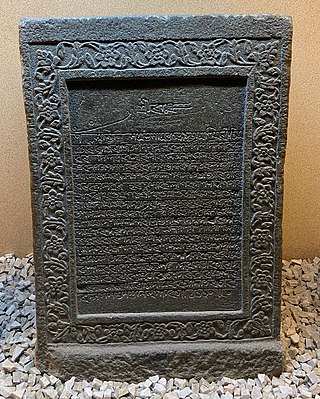
The Moamoria rebellion (1769–1805) was an 18th-century uprising in Ahom kingdom of present-day Assam that began as power struggle between the Moamorias (Mataks), the adherents of the Mayamara Sattra, and the Ahom kings. This uprising spread widely to other sections of Ahom kingdom including disgruntled elements of the Ahom aristocracy leading to two periods in which the Ahom king lost control of the capital. Retaking the capital was accompanied by a massacre of subjects, leading to a steep depopulation of large tracts. The Ahom king failed to retake the entire kingdom; a portion in the north-east, Bengmara, became known as Matak Rajya ruled by a newly created office called Borsenapati, became a tribute-paying but virtually independent territory.

Susenghphaa or Pratap Singha, was the 17th and one of the most prominent kings of the Ahom kingdom. As he was advanced in years when he became king, he is also called the burha Raja. His reign saw an expansion of the Ahom kingdom to the west, the beginning of the Ahom-Mughal conflicts, and a reorganization of the kingdom with an expanded Paik system and reoriented village economy designed by Momai Tamuli Borbarua. His expansion to the west is underlined by the two new offices that he created: that of the Borbarua and the Borphukan. The alliances he formed with the rulers of Koch Hajo resulted in formation that successfully thwarted Mughal expansion. The administrative structure that he created survived until the end of the Ahom kingdom in 1826.

The Ahom kingdom was a late medieval kingdom in the Brahmaputra Valley that retained its independence for nearly 600 years despite encountering Mughal expansion in Northeast India. Established by Sukaphaa, a Tai prince from Mong Mao, it began as a mong in the upper reaches of the Brahmaputra based on wet rice agriculture. It expanded suddenly under Suhungmung in the 16th century and became multi-ethnic in character, casting a profound effect on the political and social life of the entire Brahmaputra valley. The kingdom became weaker with the rise of the Moamoria rebellion, and subsequently fell to repeated Burmese invasions of Assam. With the defeat of the Burmese after the First Anglo-Burmese War and the Treaty of Yandabo in 1826, control of the kingdom passed into East India Company hands.

Barua is a common Assamese surname. This term is different and not to be confused with the surname used by Buddhists from Bangladesh, Myanmar and Tripura, who also use Barua as surname.
Borboruah was one of the five patra mantris (councillors) in the Ahom kingdom, a position created by the Ahom king Prataap Singha in 1621. The position included both executive and judicial powers, with jurisdiction of the Ahom kingdom east of Kaliabor river and those regions not governed by the three great Gohains, and the princely estates. The region to the west of Kaliabor was governed by the Borphukan.

Borphukan was one of the five patra mantris (councillors) in the Ahom kingdom, a position that was created by the Ahom king Prataap Singha. The position included both executive and judicial powers, with jurisdiction of the Ahom kingdom west of Kaliabor river. The headquarters of Borphukan was based in Kaliabor and after the Battle of Itakhuli in 1681 in Itakhuli in Guwahati. This position was particularly important and powerful because of its distance from the Ahom capital, giving it a semblance of independence. The region to the east of Kaliabor was governed by the Borbarua. Lachit Deka later became Borphukan or the ruler of Lower Assam according to the fifth chronicles of the Satsori Asom Buranji.

Suklingphaa, or Kamaleswar Singha, was a king of the Ahom kingdom. He came to power when he was a toddler, and died in his teens during a small pox epidemic. The de facto ruler during his reign was Purnanada Burhagohain, who was able to consolidate power after installing him on the throne; and his parents Kadamdighala and Numali also were very powerful. Kamaleswar Singha's reign witnessed the suppression of Moamoria rebellion and restoration of Ahom rule over Upper Assam. The Dundiya Revolution in Kamrup was also suppressed during his reign. In Nagaon, the Ahom army also managed to defeat a coalition of Moamoria rebels and the Kacharis of Kachari Kingdom. Much of this was the handiwork of Purnananda Burhagohain and not Kamaleshwar Singha.

Suklamphaa also Ramadhwaj Singha was a king of the Ahom kingdom. His reign is known for the rise in power of Debera Borbarua and the beginning of a ten-year period of power struggles among high officials of the kingdom that saw quick changes in kings via court intrigues and internal armed conflicts.
Hazarika was a Paik officer under the administration of the Ahom kingdom and Koch kingdom. The commander over 1,000 (Hazar) paiks was known as a Hazarika. As it was a purely administrative position, the title holder could belong to diverse ethnic groups and religions.
Saikia was a Paik officer of the Ahom militia who led a hundred paiks. The Koch kingdom had a similar system in place. As it was a purely administrative position, the title holder could belong to diverse ethnic groups or religions. Today, this title is used as a surname by Assamese people of various ethnic origins. The post of Saikia in the Paik system was higher in rank to the Bora but lower in rank to the Hazarika.

Suhung also known as Samaguria Rojaa Khamjang was a king of the medieval Indian Ahom kingdom who ruled for a very short period. While most of the chronicles put the number of days of his reign as 20, in some chronicles the duration of his reign was shown as one month and fifteen days. Suhung was installed as king of Ahom kingdom by Debera Borbarua after the latter poisoned Ahom king Ramdhwaj Singha. His reign was characterized by the atrocities committed by his minister Debera Borbarua. Finally, Suhung decided to get rid of Debera Borbarua and put an end to his reign of tyranny, but the powerful minister outsmarted the king, by secretly poisoning his medicine and killing him.

Gobar was the king of the Ahom kingdom for a duration of about three weeks. He was the first king from Tungkhungia line of Ahom dynasty, and the father of Gadadhar Singha, a later Ahom king. He was installed by Debera Borbarua, a powerful officer in the capital Garhgaon. Gobar was the last king installed by Debera before both were removed and executed by the Saraighatia Ahom officers under the leadership of Atan Burhagohain.

Sujinphaa also Arjun Konwar, was a Namrupiya king of the Ahom kingdom. Atan Burhagohain installed him on the throne after removing Debera Borbarua from power and deposing the previous king, Gobar Roja. Sujinphaa began his reign well with proper advice and support from Atan Burhagohain and other nobles. But soon, acting on the advice of his wife and other advisors, the king began to defy the authority of the Burhagohain, which resulted in a head-on collision between both sides. The king successfully defended the first onslaught of Atan Burhagohain's forces, but fell to the second, which was reinforced with troops from Guwahati. Sujinphaa was deposed and blinded. Some sources state that he killed himself, while some sources maintain that he was murdered by Bhatdhara Phukan, the brother of Laluksola Borphukan.

Sudoiphaa or Tej Singha was the king of Ahom kingdom from 1677 CE to 1679 CE. After deposing king Sujinphaa, Atan Burhagohain, the Prime-Minister of Ahom Kingdom, installed Sudoiphaa in the throne. Sudoiphaa's reign witnessed the end of the ministerial dictatorship of Atan Burhagohain and rise of Laluksola Borphukan, the Ahom Viceroy of Guwahati and Lower Assam, as the real authority behind the throne. In order to gain absolute authority in the Royal Court, Laluksola Borphukan, treacherously surrendered the garrison of Guwahati to Mughals, and held Atan Burhagohain and other nobles as captive. Sudoiphaa's effort to reestablish his authority and bring the ambitious Laluk Sola Borphukan to justice for his treachery against his country and collaboration with the foreigners, finally led to his own deposition and execution by the ambitious minister.

Sulikphaa also, Ratnadhwaj Singha was the twenty-eighth king of the Ahom Kingdom. He was only 14 years of age when Laluksola Borphukan, the Ahom viceroy of Guwahati and Lower Assam, raised him to the throne, after deposing the former king, Sudoiphaa. Due to his young age at the time of his accession, he was generally known as Lora Raja or the Boy-king. His reign was characterized by the atrocities committed by Laluksola Borphukan, who held the real authority behind the throne, in his name. The most notorious act which occurred during his reign was the mutilation of Ahom princes belonging to different phoids or clans of the Royal Ahom Dynasty. While most of the Ahom princes suffered mutilation, Prince Gadapani, the future king Gadadhar Singha, from the Tungkhungia branch of the Royal Ahom Dynasty, escaped, due to the efforts of his illustrious wife, Joymoti Konwari, who refused to divulge any information regarding her husband's whereabouts even in face of the tortures inflicted by the henchmen of Lora Raja. After Laluksola Borphukan was assassinated in court intrigues, the nobles at Kaliabar decided to get rid of the incompetent Lora Raja and put an able prince on the throne. Prince Gadapani, who was living incognito at a place called Rani in Kamrup at that time, was nominated for the throne. Sulikphaa or Lora Raja was deposed and exiled to Namrup, only to be executed later on.
Bora, also spelled Borah or Barah, is an Assamese surname used commonly throughout Assam.

Sonowal is a designation of the gold-washers of Assam. They were previously addressed as Xunia thakur.
Mohanmala Maladev Gohain, Barjana Gohain or simply known as Mohanmala Gohain, was the third son of Rudra Singha, a king of the medieval kingdom of Ahom in Assam, present-day India.

Momai Tamuli Borborua (?–1650) also known by his birth name Sukuti was an able Ahom general, statesman, and noble and the first incumbent to the office of the Borbarua. He is popularly known for systemizing the paik system and for being the father of Ahom commander-in-chief Lachit Borphukan.







